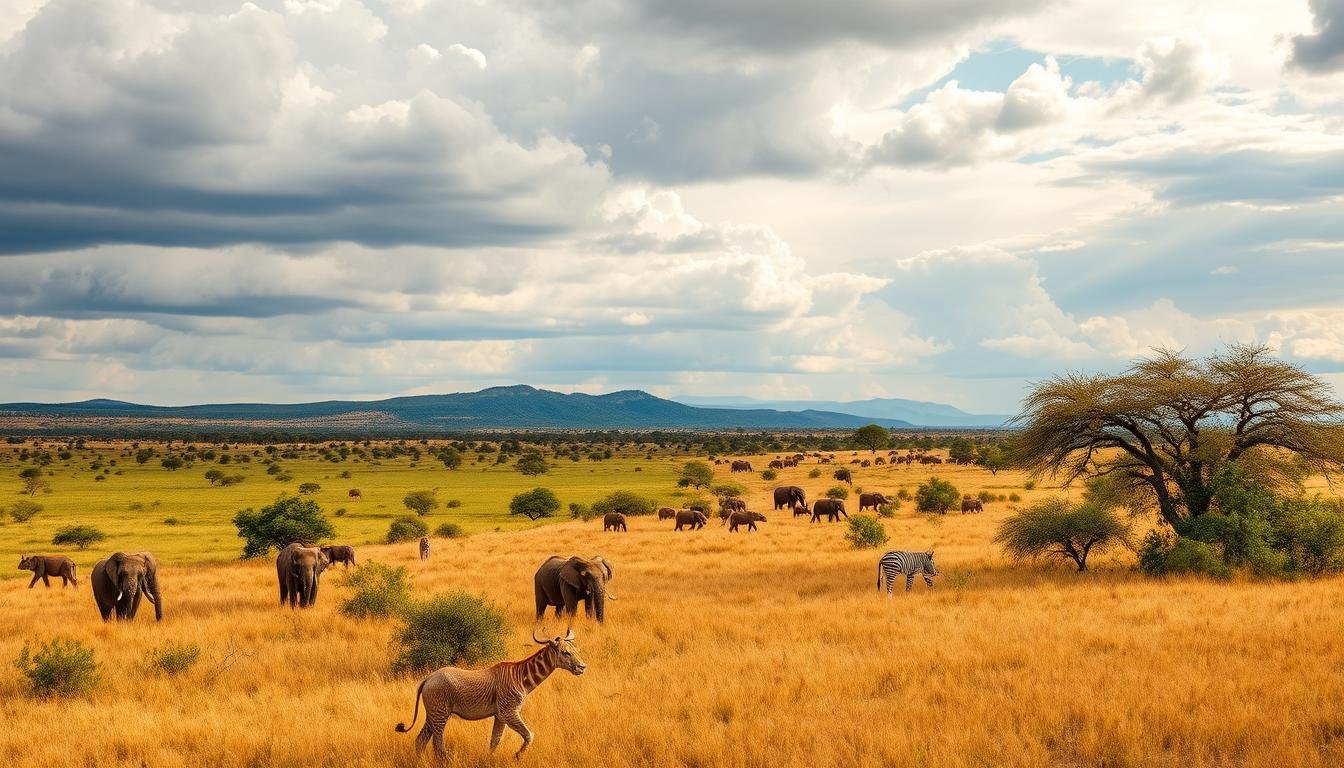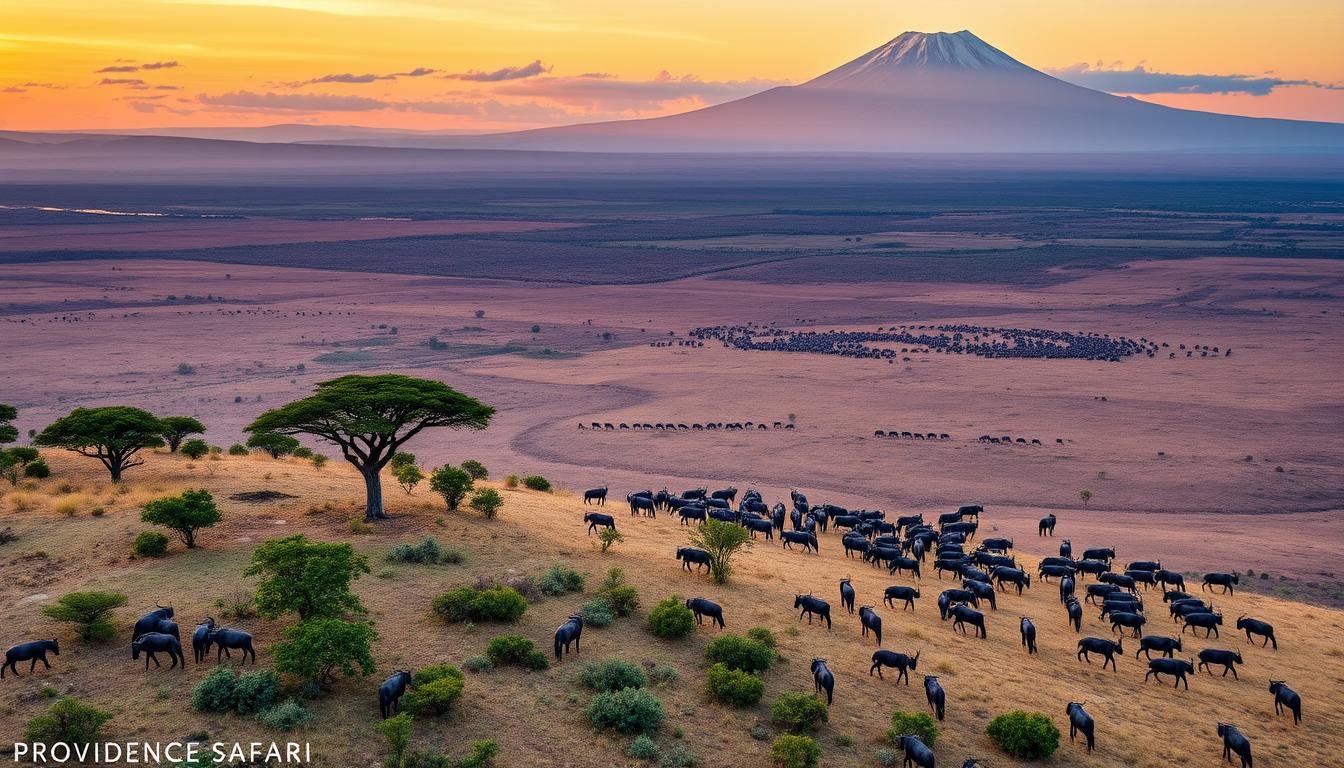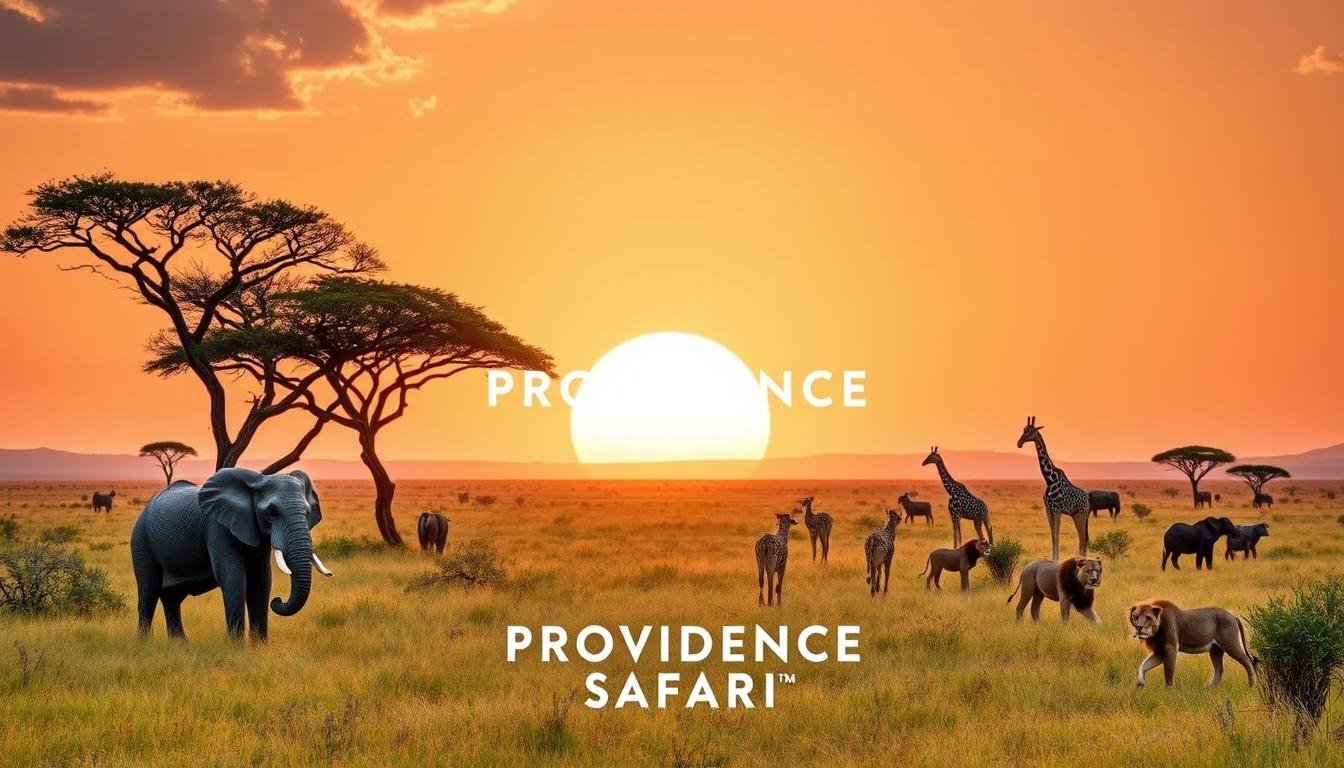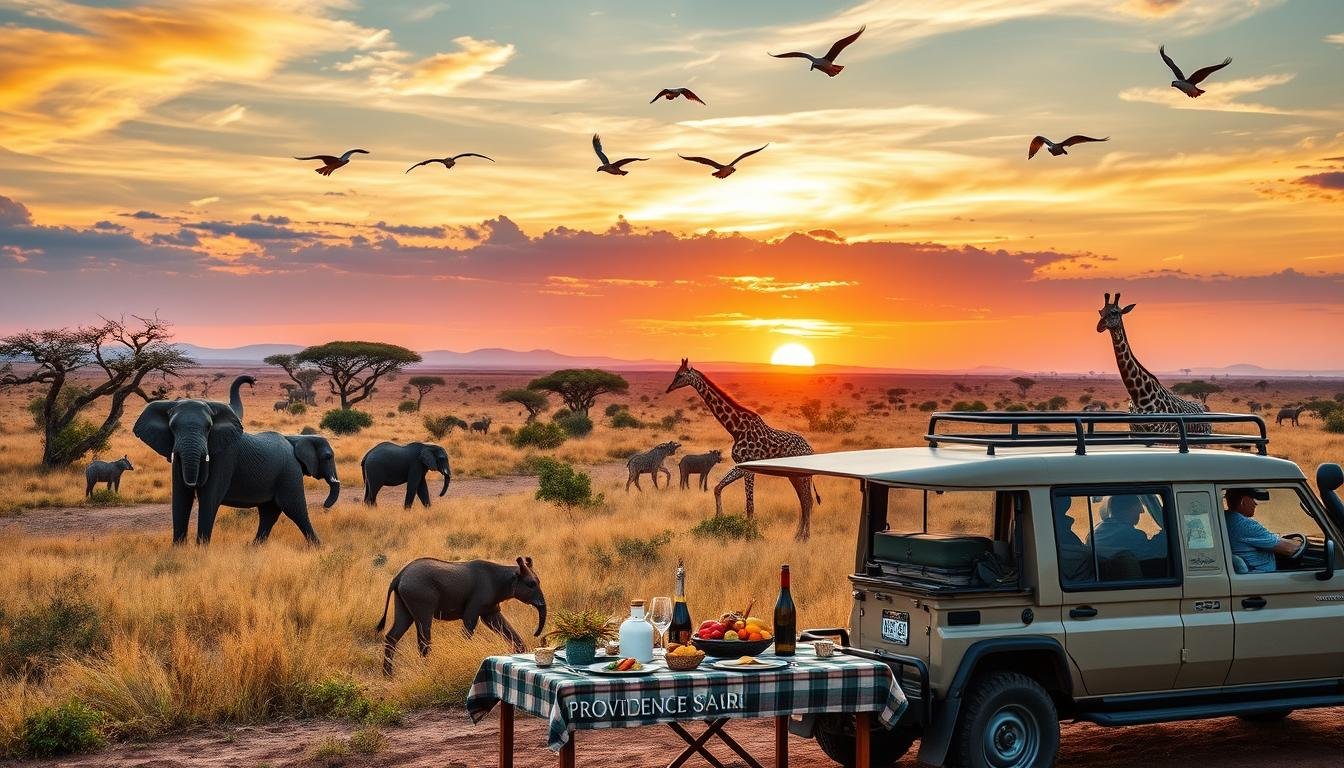
28 Nov
Best time for African safari Tanzania: Start an unforgettable journey by finding the best time for an African safari in Tanzania. This guide will show you the seasonal changes, wildlife migrations, and planning tips. These will help you make the most of your Tanzanian safari adventure.
Tanzania is famous for its wide range of wildlife. From the huge Serengeti plains to the famous Ngorongoro Crater. Whether you want to see the Great Migration, meet the Big Five, or dive into the rich culture, knowing the best safari seasons is key for an amazing trip.
Key Takeaways
- Discover the best times to embark on a Tanzanian safari based on seasonal variations and wildlife patterns.
- Explore the distinct dry and rainy seasons and how they impact safari experiences.
- Understand the importance of the shoulder seasons and their advantages for wildlife viewing.
- Plan your safari to coincide with the Great Migration and other wildlife events for unforgettable encounters.
- Gain insights into the diverse national parks and their unique offerings to tailor your safari itinerary.
Understanding the African Safari Seasons
Planning an African safari in Tanzania means knowing the seasons. Tanzania has two main seasons: the dry and rainy. Each season offers a unique experience.
The Dry Season: June to October
The dry season runs from June to October. It’s a favorite time for safaris. The weather is sunny and dry, making it easy to see animals.
It’s the best time to see the Serengeti wildebeest migration. The animals gather around water, making them easy to spot.
The Rainy Season: November to April
The rainy season is from November to April. It’s a different safari experience. The weather can be unpredictable, but the landscape is lush and green.
This is the best time to see newborn animals. Birdwatchers will love the migratory birds that come during this season.
Importance of the Shoulder Seasons
The shoulder seasons, like May and November, are also great. They offer a mix of the dry and rainy seasons. You’ll find fewer crowds and lower prices.
These months let you see the landscape and wildlife change. It’s a unique experience.
SeasonMonthsCharacteristics
Dry Season
June to October
Sunny, dry weather; excellent wildlife viewing; ideal for witnessing the Serengeti wildebeest migration
Rainy Season
November to April
Occasional downpours; lush, verdant landscape; prime time for newborn wildlife and migratory birds
Shoulder Seasons
May, November
Balanced weather; fewer crowds; more affordable rates; gradual changes in landscape and wildlife
Knowing about Tanzania’s tanzania dry seasons and tanzania rainy seasons helps plan your safari. You can choose the best time for your adventure.
Weather Patterns and Their Impact on Safaris
Planning a Tanzania safari? Knowing the weather is key. Tanzania’s climate affects your safari, from seeing wildlife to feeling comfortable.
Temperature Variations Throughout the Year
Tanzania’s temperatures change a lot. The dry season, from June to October, is warm and dry. Temperatures are between 75°F and 90°F.
The rainy season, from November to April, is cooler and more humid. Temperatures are around 65°F to 80°F.
Rainfall and Its Effects on Wildlife Viewing
Rainfall is important for safaris. The dry season is great for seeing animals. They gather at water sources, making them easier to spot.
The rainy season offers a lush view. It’s a chance to see newborn animals and migrating herds.
Best Climate Considerations
- The dry season (June to October) is best for wildlife viewing. Animals are more active and easier to see.
- The rainy season (November to April) brings a green landscape. But, animals may be harder to find.
- The shoulder seasons (May and November) are a good middle ground. They have nice weather and fewer people, making them the best months for tanzania safari.
Understanding Tanzania’s weather helps plan your safari. You can pick the best months for tanzania safari for a memorable wildlife adventure.
Wildlife Migration: The Great Migration
The wildebeest migration in Tanzania is a breathtaking sight. It’s known as the Great Migration. Millions of wildebeests, zebras, and other animals move across Africa. They search for new places to eat and drink.
Overview of the Great Migration
The Great Migration is a big circle across the Serengeti. The animals move in a clockwise direction. They follow the rains and food.
Timing Our Visit for Optimal Viewing
When to see the tanzania wildebeest migration is key. The best time is during the dry season. This is usually from July to October. You’ll see the animals cross rivers during this time.
Regions to Witness the Migration
The tanzania migration seasons offer great spots to see the migration. The Serengeti National Park, Ngorongoro Conservation Area, and Maasai Mara in Kenya are top places. Each spot gives a different view of the animals’ journey.
RegionBest Time to VisitHighlights
Serengeti National Park
December to March
Calving season, predator activity
Ngorongoro Conservation Area
June to October
River crossings, predator interactions
Maasai Mara, Kenya
July to October
River crossings, large concentrations of wildlife
Knowing the tanzania wildebeest migration patterns helps plan your safari. You can see the calving season, river crossings, or predator interactions. The Great Migration is an unforgettable experience that shows the beauty of Africa’s wild.
National Parks to Explore in Tanzania
Tanzania is a paradise for safari lovers, with three top spots: Serengeti, Ngorongoro Crater, and Tarangire National Park. Each park offers a unique wildlife adventure that will stay with you forever.
Serengeti National Park
The Serengeti is a top choice for safaris. It’s vast and teeming with wildlife, including the Big Five. The annual wildebeest migration is a sight to behold, with millions of animals crossing the plains.
Ngorongoro Crater
The Ngorongoro Crater is a natural wonder in the Ngorongoro Conservation Area. It’s a wildlife paradise, with a chance to see rare black rhinos. Exploring the crater floor offers stunning views and encounters with iconic African species.
Tarangire National Park
Tarangire National Park is a hidden treasure. It’s famous for its elephants and diverse landscapes. Visitors can see many animals, including lions and leopards, against the backdrop of majestic baobab trees.
National ParkUnique FeaturesNotable Wildlife
Serengeti National Park
Vast, sprawling ecosystem with diverse habitats
Big Five, wildebeest migration
Ngorongoro Crater
Ancient volcanic caldera, diverse ecosystems
Rare black rhino, wide array of species
Tarangire National Park
Impressive concentration of elephants, diverse landscapes
Elephants, lions, leopards, baobab trees
Tanzania’s national parks offer unforgettable safari experiences. Whether you’re drawn to the Great Migration, the tranquility of Ngorongoro, or Tarangire’s adventure, Tanzania’s parks will exceed your dreams.

Special Events: When to Plan Our Safari
Planning a Tanzania safari? Think about the special events that can make it unforgettable. Events like the calving season in Ndutu and the Serengeti’s predator-filled dry season are once-in-a-lifetime experiences.
Calving Season in Ndutu
The calving season in Ndutu is a highlight for many. From December to March, thousands of wildebeest and zebra have their young. This is a nature spectacle like no other. Newborns attract predators, offering thrilling sights and great photo chances.
Predator Season in the Serengeti
The Serengeti is famous for its predators. June to October is their peak time. Lions, leopards, cheetahs, and hyenas hunt and defend their territories. Seeing these predators in action is awe-inspiring.
Cultural Events and Their Influence
Adding cultural events to your safari enriches your experience. Events like Maasai dances and local harvest festivals show Tanzania’s vibrant traditions. Visiting during these times offers a deeper understanding of local communities and their land.
EventLocationTiming
Wildebeest Calving Season
Ndutu
December – March
Predator Season
Serengeti
June – October
Maasai Cultural Festival
Ngorongoro Crater
August
Harvest Festival
Tarangire National Park
November
Aligning your safari with these events makes it unforgettable. It showcases Tanzania’s natural and cultural wonders in a unique way.
Planning Our Safari Itinerary
Planning our tanzania safari tours can feel overwhelming. Do we choose a short, action-packed trip or a longer journey? Should we visit multiple places for a deeper experience? The great news is, our safari can be made just for us, fitting our style and preferences.
Choosing Between Short and Long Safaris
If time is tight, a 3-5 day safari in Tanzania is still amazing. These quick trips focus on top spots like the Serengeti and Ngorongoro Crater. But, longer safaris of 7 days or more let us explore more and see events like the Great Migration.
Split Safaris: Combining Destinations
Another choice is a split safari, visiting different places. This way, we see Tanzania’s varied landscapes, from the Serengeti to Tarangire National Park. Mixing destinations makes our safari more complete and exciting.
Customizable Safari Experiences
What’s special about planning our tanzania safari tours is making it our own. Whether we want a family trip, a photo safari, or to learn about local culture, many tours can be customized. This ensures our Tanzanian adventure meets our exact wishes.
By thinking about the safari’s length, where we go, and what we want, we can make an unforgettable trip. With so many choices, our tanzania safari tours can be truly remarkable.
Preparing for the Safari Experience
We’re excited for our African safari in Tanzania. It’s important to prepare well for the trip. This includes choosing the right gear for the weather and focusing on our health and packing must-haves. These steps will help us enjoy our safari to the fullest.
Recommended Gear for Different Seasons
Tanzania’s weather changes a lot throughout the year. We need clothes and gear that can adapt. In the dry season, from June to October, we should wear light, breathable clothes and protect ourselves from the sun. When it rains, from November to April, we’ll need waterproof clothes, warm layers, and sturdy shoes.
- Lightweight, quick-drying shirts and pants
- Comfortable, closed-toe hiking shoes
- Sun hat, sunglasses, and high-SPF sunscreen
- Warm layers, such as a fleece jacket or light sweater, for cooler evenings
- Raincoat or poncho for the rainy season
Health Considerations and Vaccinations
Our health is key for a great safari. Before we go, we should talk to a doctor about shots and how to stay healthy. This includes getting vaccinated against diseases like yellow fever and taking steps to prevent malaria.
- Routine vaccinations: make sure all shots are up-to-date
- Recommended vaccinations: yellow fever, hepatitis A and B, typhoid, and meningococcal meningitis
- Malaria prevention: talk to a doctor about antimalarial drugs
- Travel insurance: get a policy that covers medical emergencies
Packing Essentials for Our Trip
Packing right is crucial for a great safari. Besides the right clothes and health items, don’t forget these:
- Binoculars for getting close to wildlife
- Camera equipment and extra batteries or chargers
- Personal toiletries and any needed medicine
- Lightweight, quick-drying travel towel
- Reusable water bottle to stay hydrated
By carefully preparing for our safari, we’ll have a safe, comfortable, and memorable trip. We’ll explore Tanzania’s amazing wildlife.
Booking Our Safari: Tips and Strategies
When we start our tanzania safari tours, picking a good safari tour operator is key. It makes sure our trip is smooth and memorable. With so many choices, a few tips can guide us to the right one.
How to Choose a Reputable Safari Tour Operator
Look for a safari tour operator with a solid reputation and good reviews. They should also care about the environment. Ask them about their guides, vehicles, and where you’ll stay.
Budgeting for Our Safari Adventure
Safaris can cost a lot, so we need to plan our budget well. Think about how long we’ll be there, how fancy we want it, and any extra activities. By comparing prices, we can find a safari that’s just right for us.
Best Times to Book for Deals
When we book can affect how much we pay. Booking early (6-12 months) or during the off-peak seasons can get us better prices. Being flexible with our travel dates can also lead to discounts.
By using these tips, we can book our tanzania safari tours with confidence. We’re ready for an amazing adventure in Africa.

Choosing the Right Accommodation
Planning your Tanzania safari adventure means picking the right place to stay. You can choose from traditional safari camps to luxurious hotels. We’ll look at the different types of lodging, where they are, and some special places to stay.
Camps vs. Hotels: Immersing Yourself in the Safari Experience
Deciding between a safari camp and a hotel is a big choice. Safari camps put you in the middle of nature. You can hear the African wilderness at night. Hotels, on the other hand, offer more comfort and amenities.
Strategic Locations: Maximizing Your Wildlife Viewing Opportunities
Where you stay can affect how much wildlife you see. Places near national parks, like the Serengeti, are great. They let you start game drives right from your door, saving time and increasing your chances of seeing animals.
Unique Stays: Glamping and Luxury Retreats
Tanzania has special places to stay for an unforgettable safari. Glamping mixes luxury with camping, letting you enjoy the stars while being comfortable. There are also luxury retreats for a peaceful break after exploring.
Choosing where to stay in Tanzania depends on what you want, how much you can spend, and how much you want to be in nature. By thinking about these things, you can make your safari trip exactly what you dream of.
Responsible Wildlife Viewing Practices
Planning a safari in Tanzania’s national parks means we must follow responsible wildlife viewing practices. Ethical tourism makes our experience better and helps protect the country’s natural beauty and local communities.
Understanding Ethical Safari Guidelines
We’ll learn the ethical guidelines from the Tanzania National Parks Authority before our safari. These rules help us not harm the ecosystem and keep both wildlife and visitors safe. We’ll keep a safe distance from animals, avoid loud noises, and stick to the safari routes.
Supporting Local Communities
Our safari also means supporting local communities. By using local guides, buying from local shops, and joining community projects, we help their economy and culture. This enriches our visit and helps keep traditional ways of life alive.
Wildlife Conservation Education
During our safari, we’ll learn about wildlife conservation in Tanzania. We’ll visit centers and attend talks to understand the importance of protecting nature. By sharing what we learn, we can inspire others to help protect these natural wonders.
Ethical Safari PracticesCommunity EngagementConservation Education
Maintain respectful distance from wildlife
Support local guides and vendors
Visit wildlife rehabilitation centers
Avoid sudden movements and loud noises
Participate in community-based initiatives
Attend educational talks and workshops
Adhere to designated safari routes
Contribute to sustainable tourism efforts
Become an ambassador for conservation
By following responsible safari practices, we make a positive impact. Ethical wildlife viewing, community support, and learning about conservation help preserve Tanzania’s wonders for future generations.

Safety Considerations During Our Safari
As we get ready for our exciting safari in Tanzania, safety is key. We need to know how to handle wildlife and stay healthy. Let’s look at the important safety tips that will make our safari better.
Wildlife Safety Rules
Seeing Africa’s amazing wildlife is a big part of the safari fun. But, we must be careful and respectful. Here are some wildlife safety rules to follow:
- Maintain a safe distance from all animals, and never approach them closely.
- Refrain from making sudden movements or loud noises that may startle the wildlife.
- Follow the instructions of our experienced safari guides at all times.
- Stay inside the vehicle during game drives, unless explicitly permitted by the guide.
Health and Emergency Preparedness
Our health and safety are top priorities on this safari. Before we go, we should talk to doctors about shots and precautions. We also need to know the emergency plans and contact info from our safari company.
Travel Insurance Importance
Travel insurance is a must for our Tanzanian safari. It helps with medical emergencies, trip cancellations, and other surprises. When we book, we should pick an insurance that fits our needs.
By focusing on safety, health, and being ready for emergencies, we can enjoy the best of Tanzania’s safari. We’ll make unforgettable memories while staying safe.
Food and Dining Options on Safari
Your tanzania safari tours in Tanzania offer a thrilling culinary adventure. You’ll enjoy a wide range of dining experiences. From hearty camp meals to fine dining, every bite will delight your senses and introduce you to local flavors.
Safari Dining: From Camps to Fine Dining
At your safari camp, enjoy wholesome, freshly-prepared meals that fuel your adventures. These meals often include local Tanzanian specialties and international favorites. You might even have a picnic lunch in the stunning landscapes.
For a more refined dining experience, Tanzania’s safari lodges and hotels serve world-class cuisine. Savor contemporary African dishes in elegant settings with breathtaking views of the wilderness.
Traditional Tanzanian Cuisine to Try
Dive into Tanzania’s rich culinary heritage by trying its traditional dishes. Enjoy aromatic Swahili-style curries and the classic staple, ugali, made from maize flour. It pairs well with many local dishes.
Try the vibrant flavors of Tanzanian street food, like mishkaki and samosas. Don’t miss the chance to taste tropical fruits like mangoes, pineapples, and passion fruits during your tanzania safari tours.
Special Dietary Needs Considerations
Whether you’re vegetarian, vegan, or gluten-free, your tanzania safari tours can meet your dietary needs. Most safari operators and lodges are skilled in catering to various diets. This ensures a fulfilling and delightful culinary experience throughout your journey.
Exploring Tanzania’s diverse and flavorful cuisine enriches your safari adventure. It adds a deeper layer of cultural understanding and appreciation.

Tanzanian DishDescription
Ugali
A traditional staple made from maize flour, often served as a accompaniment to stews and meat dishes.
Mishkaki
Grilled meat skewers, a popular Tanzanian street food.
Swahili Curry
A fragrant, coconut milk-based curry featuring a blend of spices and either meat, seafood, or vegetables.
Samosas
Savory pastries filled with a variety of ingredients, such as minced meat, vegetables, or lentils.
Capturing Our Safari Experience
As we start our tanzania peak safari season adventure, taking photos becomes a big deal. Whether you’re good at photography or just starting, learning to take great wildlife photos can make your safari memories even better.
Photography Tips for Wildlife
Photographing the animals in the area needs patience and planning. Make sure you have a camera that can take fast photos and has good lenses. Also, learn how to pan, use burst mode, and frame your shots right to capture the moment.
Best Times for Golden Hour Shots
The golden hour, just before sunrise and after sunset, is perfect for taking stunning photos. The soft, warm light makes even ordinary scenes look amazing. Try to plan your safari for these times to get the best photos.
Sharing Our Experience Responsibly
When we share our safari memories, we should do it in a way that respects the environment and local people. Think about how your posts might affect the places and communities we’ve seen. Always remember to respect wildlife and be careful with cultural sensitivities. This way, we can inspire others to care for nature and support responsible travel.
Photography during our safari is about skill, caring for the environment, and loving the amazing things we see. By following these ideas, we can make photos that not only show our safari but also encourage others to explore the world.
Exploring Beyond the Safari: Additional Activities
The Tanzanian safari is a big draw for many, but there’s more to see. We can dive into the local culture and try exciting outdoor activities. This way, we can make our Tanzanian trip even better by exploring more than just wildlife.
Cultural Tours and Community Engagement
Visiting Tanzania’s diverse communities gives us a deeper look at its heritage. We can see traditional Maasai villages, watch artisans at work, and learn about their lives. These tours let us connect with locals, learn about their customs, and help the local economy.
Adventure Activities: Hiking and Hot Air Ballooning
Tanzania is great for outdoor adventures. Hiking in places like the Ngorongoro Crater or Kilimanjaro’s foothills lets us see nature up close. And, a hot air balloon ride over the tanzania migration seasons gives us a thrilling view of wildlife from above.
Day Trips to Historical Sites
Tanzania also has a rich history to explore. We can visit Olduvai Gorge, known as the “Cradle of Mankind,” or see Stone Town in Zanzibar. This UNESCO World Heritage Site is known for its architecture and lively markets.
ActivityLocationHighlights
Cultural Tour
Maasai Village
Observe traditional customs, visit with locals
Hiking
Ngorongoro Crater
Stunning landscapes, wildlife spotting
Hot Air Ballooning
tanzania migration seasons
Aerial views of the great migration
Historical Site
Olduvai Gorge
Explore the “Cradle of Mankind”
Adding these activities to our safari plan lets us fully experience Tanzania’s culture, history, and nature. It makes our trip even more memorable.
Conclusion: Making the Most of Our African Safari
Our journey through Tanzania’s stunning landscapes has been unforgettable. We’ve learned a lot about the best times for an African safari in Tanzania. Exploring the national parks has deepened our appreciation for this amazing place.
Reflecting on Our Experiences
The memories we’ve made and the wildlife we’ve seen will stay with us forever. Our safari let us connect with local communities and learn about nature’s rhythm. We’ve also seen the Great Migration and learned about the need for wildlife conservation.
Looking Ahead: Future Safari Adventures
Our Tanzanian adventure has ended, but we’re excited for more safaris. The African continent calls to us, and we can’t wait to see more. We’re ready to explore new places and keep discovering.
Final Preparations for Our Journey
As we head home, we’re making sure everything is ready for our return. We’re checking our packing lists and making travel arrangements. We want to leave Tanzania feeling fulfilled and grateful for its wonders.
